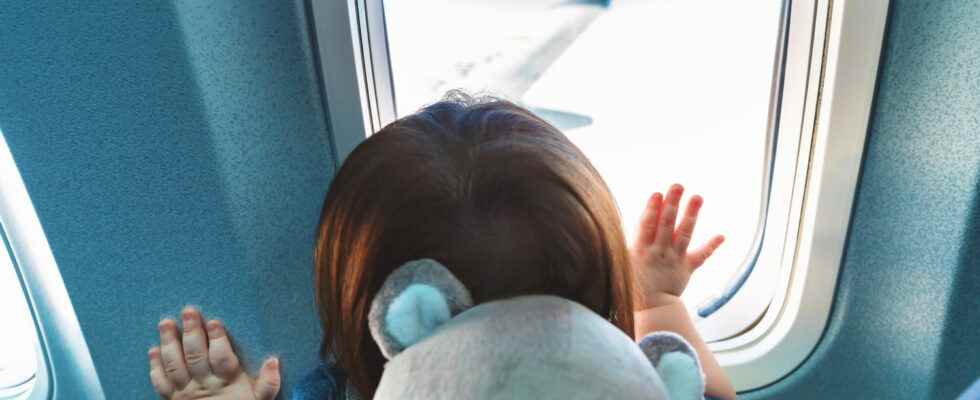You are traveling by plane for the first time with baby and you have a lot of questions. Can you take your bottle of water, baby bottle, compote without being limited? What documents to take with you? Where to put your stroller? The answers to your questions.
Traveling by plane with a baby is quite an organization. From the cabin stroller to the preparation of your bottle, change or even documents and identity papers, be careful not to forget anything. We help you take stock of all the elements to think about before embarking with a toddler. Rest assured, some Airlines companies offer various services to make your life easier during the trip. Here’s what you need to know.
At what age can a baby travel by plane?
A newborn baby can fly from one week for a short flight, or from three weeks for a long-haul flight. It is still advisable to ask the question to your pediatrician before flying with baby for the first time, depending on his state of health.
On board the plane, can we take a one-liter bottle of water for the preparation of the bottle?
Yes. There are no restrictions when it comes to baby food, until the age of three. “The medicines and foods that your baby needs” are authorized without restriction or prescription” specifies the Paris Airports group. You can therefore take milk powder and a bottle of water with you (especially if the one you use is special and the brand is not on sale at airports, such as Mont-Roucous for example). ) or compotes and small pots. Be aware that at the time of the check, the security guards may ask you to taste some of the food you are transporting. It is therefore recommended, just in case, to take containers that can be closed easily.
Identity document, passport, family record book… What documents should you take to travel with your baby?
Like adults, baby’s ID or passport are essential for travelling, depending on the destination, within or outside Europe. But in some cases, the family book or, failing that, the birth certificate will be essential for you to pass the customs! “I didn’t know I needed these documents, and luckily my husband had recorded the birth certificate in his phone, otherwise I would have been stuck because we are not married, and we do not have the same surname“, explains Marjorie, mother of Gaspard, aged three months. Indeed, to avoid any risk of kidnapping, especially when the mother does not have the same name as her child, it is necessary to prove that you are indeed Finally, among the other documents not to forget when traveling away from home: baby’s health record!
What if I don’t have a cabin stroller?
Some strollers like the Yoyo are particularly suitable for placing on the plane, above you, like for hand luggage. If you don’t have a “small stroller”, all you have to do is drop off yours just before boarding the plane. Remember to label it when checking in the luggage, to retrieve it later, at the same time as the suitcases. They often often placed on a conveyor belt, right next to it. Depending on the country and airline, your pushchair may be returned to you when you exit the plane.
Can we have a cot on board the plane?
On the long-haul flights, baby cots can be made available to travelers in all classes. Number of cots being limited on a flight, it is essential to inform the airline as soon as possible of the presence of your baby.
Depending on the airlines, children under the age of two do not always have an assigned seat. Your baby will then have to travel on your lap. You will also have to hold it in your arms during the take-off and landing phases, and in case of turbulence. Babies are held by a specific belt attached to the attendant’s belt. If they have their own seat, infants must travel in an approved “shell” type car seat. It must be certified for air travel and be suitable for the dimensions of the aircraft seat. It is the parents who are responsible for installing it.
Breastfeed baby during take-off and landing
Is it time to take off or land? To avoid baby stress due to engine noises and the special feeling of the plane, but especially against the pressure of the air in the ears, it is recommended to make your baby suckle by giving him the breast, a bottle of milk, or a pacifier to suck. Also, don’t forget to take his security blanket and a small blanket with you so he doesn’t get cold.
